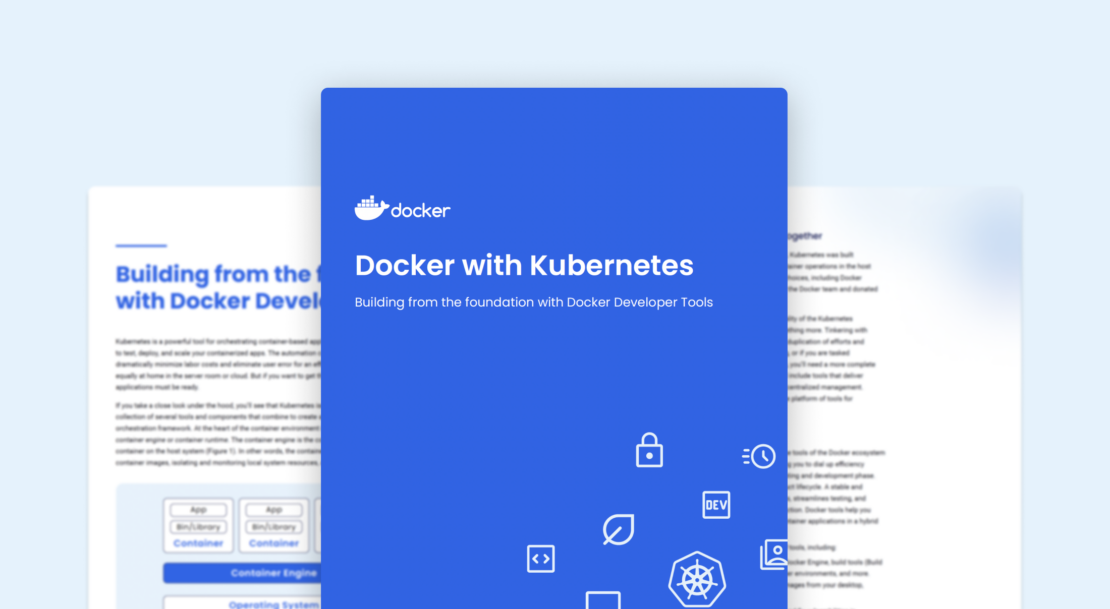Docker and Kubernetes are two of the most popular technologies for containerized development. Docker is used to package applications into containers, while Kubernetes is used to orchestrate and manage those containers in production.
Kubernetes changed how we develop and deploy containerized applications, providing a powerful orchestration platform that automates tasks such as scaling, load balancing, and self-healing. To realize the full potential of Kubernetes orchestration, your applications must be well-prepared and efficiently and securely developed from the start. That’s where Docker’s development tools come into play.

Docker is the original container engine that powers Kubernetes. Over the years, Docker’s suite of developer tools has significantly evolved to provide a comprehensive ecosystem for building, shipping, and running secure containers. Leveraging Docker’s tools with Kubernetes orchestration, developers can streamline the development process, ensure application security, and accelerate deployment.
A trusted and reliable start: Docker development tools
Having a well-developed application is essential before turning to Kubernetes orchestration. Kubernetes is a powerful tool but can be complex to configure and manage. Using Docker, teams can start with a trusted and reliable foundation for their applications, which translates to a simpler process of deploying and managing their applications with Kubernetes.
Docker helps by providing the following tools:
- Docker Desktop: An application that provides the entire environment needed to develop and run Linux, Windows, and macOS containers locally. Docker Desktop provides a consistent and secure environment for developers to build and test their applications and automates many of the tasks needed to set up a container.
- Docker Hub: The world’s largest and most widely used repository of container images, with more than 11 billion monthly image downloads. Developers can store and share their container images on Docker Hub, making deploying their applications to Kubernetes clusters on-premises or in the cloud easier.
- Docker Scout: A software supply chain solution that helps build better, more trusted applications. Developers can use Docker Scout to debut and test their containerized applications locally so they can find and fix any issues earlier in the development process.
- Docker Extensions: A set of tools and plugins that can extend existing capabilities and build new functionality into Docker Desktop. Developers can use any IDE plugin or CI/CD tool to help them better streamline workflows for building, testing, and deploying containerized applications.
A harmonious development and deployment process
Docker and Kubernetes work in harmony to create a complete ecosystem for containerized development, deployment, and management. Once developers have packaged their applications into secure containers using Docker, Kubernetes can orchestrate these containers, automating much of the work involved in managing and deploying them in production.
The benefits organizations will see from these seamless workflows include:
- Streamlined development: Features like automated builds, vulnerability recommendations, and consistent environments help speed up developer efficiency. They no longer have to manage multiple environments and tools, and they know certain tasks will be delivered in a consistent manner.
- Improved application security: Developers experience fewer disruptions in production because problems are identified and fixed earlier in their build process. Additionally, using a repository like Docker Hub helps developers avoid using insecure images that could contain malware or other vulnerabilities.
- Accelerated deployment: Because developers are more efficient and productive upfront, they deploy more rapidly against their schedule. Developers are freed to work on more complex and interesting tasks, while Docker and Kubernetes’ automation capabilities handle the more tedious work.
Conclusion
It’s not a question of how Docker and Kubernetes are different but how they best work together. By harnessing Docker’s dev tools with Kubernetes, developers can respond nimbly to market demands, streamline development processes, and ensure secure and efficient containerized applications. Ultimately, Docker and Kubernetes will improve the efficiency and productivity of the development process and reduce the risk of errors.
Want to learn more about the relationship between Docker and Kubernetes? Download our Docker with Kubernetes white paper.
